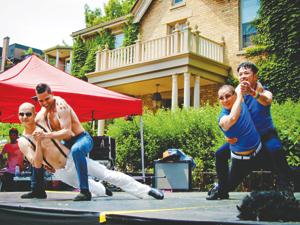In 2009, when Kelly Osbourne joined Dancing with the Stars, she polished her rocker act to be a dancing queen — claiming the show turned her into a lady.
Trevor Copp, a three-time Latin dance champ from Burlington and the creative director of Tottering Biped Theatre, was shocked. “I didn’t have a problem with her in the first place — I didn’t know she needed to change.” Copp says he realized then that ballroom dancing not only dictated a compliant female but also a culture of internalized discrimination.
“It’s an entirely cultural blind spot,” he says. “Now, I’m proud to be part of this leftwing thinking, saying, ‘Wait a minute, what do we do with this?’”
The topic inspired Copp’s play, First Dance, which questions not only the hetero-biased norms in ballroom dancing, but also the power relationship on which regulations are based.
Strict rules govern leading and following in amateur ballroom dancing. “The insidious ideas about height, weight, shape and race are completely unbelievable. When you search for a dance partner, you enter your race. Same colouring is desirable. They’re not saying minorities need not apply, but I’ve never seen a top black couple compete,” Copp says.
While same-sex dance partners are allowed in the professional-amateur category, in the amateur category, “it is illegal for a same-sex couple to walk on the floor,” Copp says. “It’s also in the way they dress. If one of my male colleagues wanted to wear a dress and I wanted to wear a suit, they wouldn’t allow that, [even if] it has nothing to do with the dance part at all.”
Copp says rules haven’t changed to allow same-sex dancers because judges claim they won’t be able to tell who is leading and who is following.
“If you can’t tell the difference as a dancer and judge only based on whether the leader has a penis and the follower wears a dress, I guess you’re in the wrong profession,” says Janine, a member of Toronto’s Rainbow Ballroom.
In the Gay Games and Outgames, “you are expected to switch from being a leader to a follower, regardless of your sexual identity,” adds Rainbow Ballroom’s Rafael Martinez.
Jennifer Jones, the owner of Joy of Dance Studio, says she supports same-sex ballroom dancing and came close to entering a same-sex couple in a recent competition, but “we all got too nervous to shake the tree,” she confesses.
“That’s the reason I’m working to have it changed,” says Paul Delaney, a competitive ballroom dancer and the founder of the Facebook advocacy group Right to Dance, which is pushing for a separate same-sex category. In 2007, Delaney says, a request to enter two female dancers was dismissed.
He was instead referred to the Gay Games. “I’ve been to the Canadian Civil Liberties and the Canadian Human Rights Association about the matter, but they dismissed me,” he says.
Copp says it’s not about sexuality. “As a dance teacher, I try to desexualize dance every day so that it is respected for the sport that it is,” he says. “The fact that there are gender roles in dance is based on [male-dominated] heterosexual roles. If you pull that out and just look at two athletes competing, then we remove the necessity for a female to be a follower and male to be a leader. It shouldn’t be based on your gender. It should be based on your ability.”

 Why you can trust Xtra
Why you can trust Xtra


